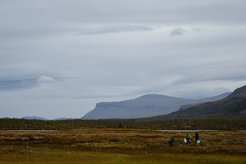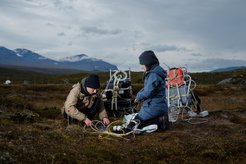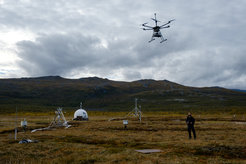Abisko

The Stordalen Mire is a palsa mire complex underlain with sporadic permafrost located in northern subarctic Sweden (68° 200 N, 19° 300 E), 10 km east of Abisko (Ábeskovvu in Northern Sámi language). Permafrost has been rapidly thawing in this region and only remains in the dry areas on the peatland (palsas). Research at the Stordalen Mire has been conducted for over a century, and a vast amount of data on greenhouse gas emissions from CH4 and CO2 has been published on this thawing permafrost peatland.

In September 2022, and May, July, and September 2023, IPAS conducted several two- four week long field campaigns in the Stordalen Mire. We collected chamber-based soil-atmosphere fluxes of CH4, CO2, and N2O along a thawing gradient (dry to wet, palsa to bog to fen) with our custom-made portable chamber system. Our aim is to investigate the environmental variables and seasonal weather conditions that drive the N2O fluxes in this nutrient-poor, disturbed ecosystem. For this, we use the unique opportunity and close collaborations to compare our manual chamber N2O flux estimates to N2O flux estimates from automated chambers (University of Eastern Finland) and N2O fluxes measured at the ICOS Abisko-Stordalen eddy covariance tower (University of Helsinki). We further aim to bring insight to interactions of the carbon and nitrogen cycle by measuring three of the most important greenhouse gases at the same time.
Additionally, first UAV-based arctic campaign was conducted in September, 2023. The UAV was instrumented with two gas analyzers for CO2 and CH4. Several flight patterns were tested during the campaign. Signal variabilities were quantified by conducting grid surveys.












